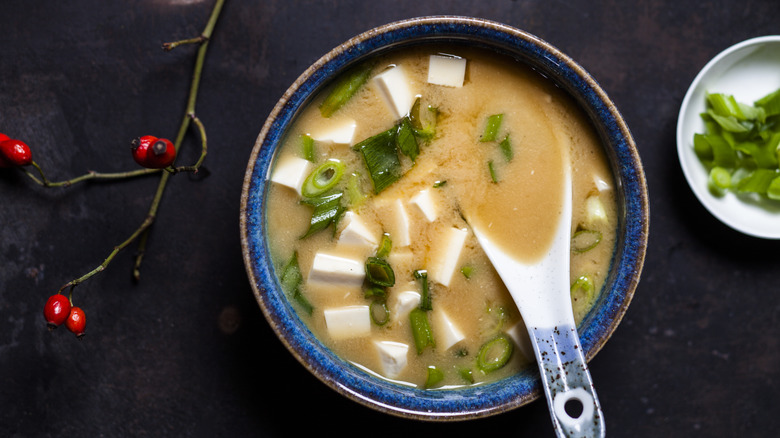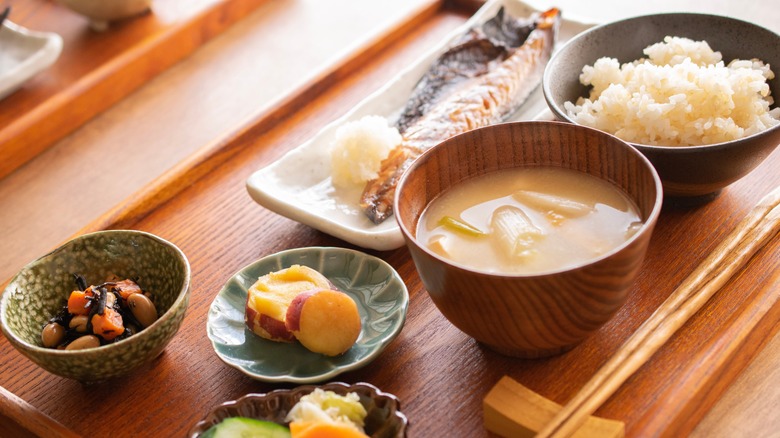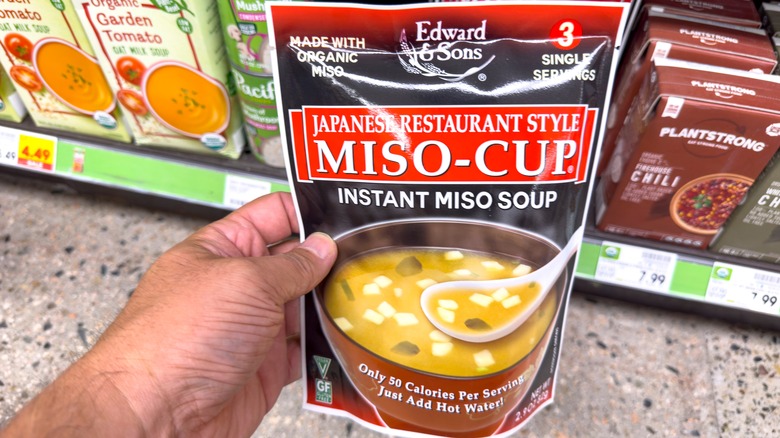Instant Miso Soup Is The Start To The Easiest Breakfast Ever
If you enjoy creative savory breakfasts, like adding mirin to your scrambled eggs, here's one idea that won't involve breaking out any frying pans, whisking any eggs, or soaking up bacon grease: Get your hands on some instant miso soup. The idea isn't to have an all-liquid breakfast (although if you do choose to eat just miso soup alone, it still has plenty of nutritional benefits as it contains probiotics and calcium). Rather, miso soup is just the starting point for a flavorful breakfast that's effortless to throw together if you have the right foods on hand.
To bulk up your breakfast, you can add all sorts of pre-chopped or pre-prepared add-ons to give yourself a full platter. The umami flavor of miso soup is a formidable backdrop for a pretty wide range of vegetables, meats, and eggs prepared in different ways, so think of it as a choose-your-own-adventure breakfast based on what you have, or what you like.
A good option that won't require prep is to buy pre-prepared deli-style extras from an Asian grocery store. The banchan section of Korean supermarket H-Mart is a perfect example. (Yes, miso is Japanese and the banchan section is predominantly Korean, but the flavors of ingredients like kimchi or marinated tofu still pair well.) The sky's the limit here: You could add pickled radish, preserved fish, or a Korean omelet, and all you'll have to do is crack open the container and put those sides on a plate or in a bowl.
You could say it's a version of Japanese breakfast
This approach of a bowl of miso soup accompanied by sides like eggs, fish, or vegetables resembles a traditional Japanese breakfast. A common Japanese breakfast is a bowl of miso soup accompanied by about five other components. These tend to be rice, some kind of protein like fish or tofu, some kind of pickle, a non-pickled vegetable item, and an egg item like an omelet.
If you're a stickler for the traditional way of doing things, you could take the full traditional Japanese approach, but naturally, you'll likely end up spending a lot more time prepping: Japanese grocery stores or Asian supermarkets like H-Mart probably stock the pickles and marinated tofu that won't require extra prep, but items like fish may require cooking (even if you can buy them pre-marinated). You would also need to cook your rice fresh unless you want to take the route of reheating day-old rice, which usually ends up dry and unpalatable. The miso soup in a Japanese breakfast also traditionally has other ingredients like tofu or vegetables — another layer of prep if you want to be very traditional about your approach. Of course, if you have extras like tofu, chopped radishes or scallions, or shredded chicken, it's a great addition to the soup without adding extra prep time.
So obviously, this "whatever's on hand" approach is a bit more flexible. It's a Japanese-ish breakfast but without all the prep.
Choosing your miso soup
There's a pretty wide variety of brands and types of miso and miso soup out there, and it goes beyond the base-level distinction between pungent red and milder white miso. At the most basic level, miso soup is made with miso, hot water, and dashi stock (a seaweed broth that is superb as a cooking liquid for rice), so you could start out with a tub of miso paste and some of that stock, but you'll still have to mix the components together.
An easier route is probably to go for instant miso soups (which can also transform your potato chip dip) that are sold as either a paste or powder and just require you to add water. You won't need to measure out miso and stock, and these soups tend to have extras like tofu or seaweed.
Asage brand instant miso is one popular choice — it can be bought online or in Japanese or Asian grocery stores. But there are plenty of brands and flavors, so consider shopping around for different options that fit your tastes; these might include add-ins like mushrooms or even dried clams. If you have any dietary restrictions, you may also want to seek out low-sodium miso (miso soup tends to be pretty salty) or gluten-free options, as some soups can be made with barley or other grains that contain gluten.


